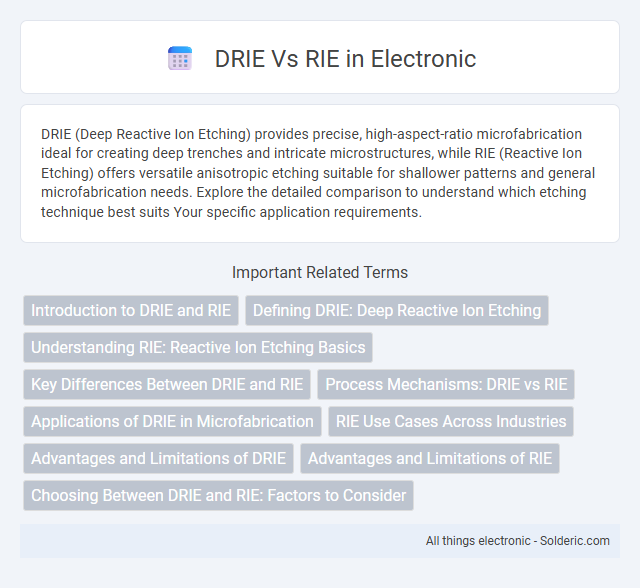DRIE (Deep Reactive Ion Etching) provides precise, high-aspect-ratio microfabrication ideal for creating deep trenches and intricate microstructures, while RIE (Reactive Ion Etching) offers versatile anisotropic etching suitable for shallower patterns and general microfabrication needs. Explore the detailed comparison to understand which etching technique best suits Your specific application requirements.
Comparison Table
| Aspect | DRIE (Deep Reactive Ion Etching) | RIE (Reactive Ion Etching) |
|---|---|---|
| Etching Depth | High (up to several hundred micrometers) | Low to moderate (typically <10 micrometers) |
| Sidewall Profile | Highly anisotropic, nearly vertical | Less anisotropic, typically tapered sidewalls |
| Process Mechanism | Alternating etch and passivation cycles (Bosch process) | Continuous etching with reactive ions |
| Applications | MEMS fabrication, microfluidics, high aspect ratio structures | Thin film patterning, surface modification, shallow etches |
| Etch Rate | Moderate to high | Relatively high but limited by selectivity |
| Equipment Complexity | Higher due to process cycling and passivation step | Lower, simpler continuous etching |
| Surface Roughness | May exhibit scalloping effect | Smoother surfaces |
Introduction to DRIE and RIE
Deep Reactive Ion Etching (DRIE) and Reactive Ion Etching (RIE) are advanced plasma etching techniques used in microfabrication to create precise patterns on substrates. DRIE is specialized for producing deep, high-aspect-ratio structures with vertical sidewalls, making it ideal for MEMS devices and microchannels. Your choice between RIE's general anisotropic etching and DRIE's deep etching depends on the required etch depth and sidewall profile for the application.
Defining DRIE: Deep Reactive Ion Etching
Deep Reactive Ion Etching (DRIE) is a specialized plasma etching technique used to create high-aspect-ratio microstructures in semiconductor materials with precise vertical sidewalls. Unlike standard Reactive Ion Etching (RIE), DRIE alternates between etching and passivation cycles, enabling deep, anisotropic etching with minimal lateral etch, ideal for MEMS device fabrication. If your application requires deep and accurate microfabrication, DRIE provides superior control over etch depth and profile compared to conventional RIE methods.
Understanding RIE: Reactive Ion Etching Basics
Reactive Ion Etching (RIE) is a plasma-based etching technique widely used in microfabrication for anisotropic pattern transfer. It employs chemically reactive ions generated in a low-pressure plasma to selectively remove material from substrates with precise control over etch depth and profile. Compared to Deep Reactive Ion Etching (DRIE), RIE offers shallower etch depths and smoother sidewalls, making it ideal for applications requiring fine features rather than high aspect ratio structures.
Key Differences Between DRIE and RIE
Deep Reactive Ion Etching (DRIE) achieves high aspect ratio structures with vertical sidewalls by alternating between etching and passivation steps, enabling precise deep trenches. Reactive Ion Etching (RIE) primarily performs shallow etching with lower aspect ratios and less anisotropic profiles, using continuous plasma without cyclic passivation. DRIE is preferred for MEMS and microfabrication requiring deep etching, while RIE suits applications needing moderate depth and faster etch rates.
Process Mechanisms: DRIE vs RIE
Deep Reactive Ion Etching (DRIE) employs alternating cycles of passivation and etching to achieve high aspect ratio structures with vertical sidewalls, while Reactive Ion Etching (RIE) uses a continuous plasma etch process resulting in more isotropic profiles. DRIE's mechanism involves depositing a protective polymer layer followed by anisotropic ion bombardment that selectively etches exposed areas, making it ideal for deep etching of silicon. In contrast, RIE relies on a combination of chemical reactions and physical ion bombardment in a single step, typically producing shallower and less directional etches suited for surface patterning.
Applications of DRIE in Microfabrication
DRIE (Deep Reactive Ion Etching) enables the fabrication of high-aspect-ratio microstructures with precise vertical sidewalls, making it essential in MEMS (Microelectromechanical Systems) devices and microfluidic channels. It outperforms RIE in creating deep trenches and intricate patterns required for sensors, actuators, and semiconductor components. DRIE's capability to etch deep features with minimal undercutting is critical for advanced microfabrication and nanotechnology applications.
RIE Use Cases Across Industries
Reactive Ion Etching (RIE) is widely used in semiconductor manufacturing, microelectromechanical systems (MEMS), and photonics for precise etching of thin films with high anisotropy and control. Your production processes benefit from RIE's capability to etch complex patterns on silicon wafers, glass, and polymers, enabling the creation of microchips, sensors, and optical devices. Compared to Deep Reactive Ion Etching (DRIE), which specializes in deep, high-aspect-ratio etching, RIE suits applications requiring shallower etch depths and finer feature resolution.
Advantages and Limitations of DRIE
DRIE (Deep Reactive Ion Etching) offers unparalleled precision and the ability to create high aspect ratio microstructures with vertical sidewalls, ideal for MEMS, microfluidics, and semiconductor fabrication. Its limitations include slower etch rates compared to RIE (Reactive Ion Etching) and higher equipment complexity, which can lead to increased costs and longer processing times. Your choice of DRIE will depend on the need for deep, precise etching versus faster, less intricate patterns achievable with standard RIE.
Advantages and Limitations of RIE
Reactive Ion Etching (RIE) offers superior control over etch profiles and lower aspect ratio features compared to Deep Reactive Ion Etching (DRIE), making it ideal for precise microfabrication in semiconductor processing. RIE provides uniform etching with less substrate damage and simpler equipment requirements; however, it typically struggles with deep, high-aspect-ratio structures due to limited anisotropy and slower etch rates. The technique's limitations include reduced depth control and poorer selectivity when etching complex multilayer materials, which are areas where DRIE excels.
Choosing Between DRIE and RIE: Factors to Consider
When choosing between DRIE (Deep Reactive Ion Etching) and RIE (Reactive Ion Etching), consider the required etch depth and aspect ratio, as DRIE excels in achieving deep, high-aspect-ratio structures while RIE is better suited for shallower, precise etching. Your material type and etching profile requirements also influence the decision, with DRIE offering more anisotropic profiles and RIE providing greater control over etch uniformity. Cost, equipment availability, and specific application needs are critical factors that determine the optimal etching process for your project.
DRIE vs RIE Infographic

 solderic.com
solderic.com